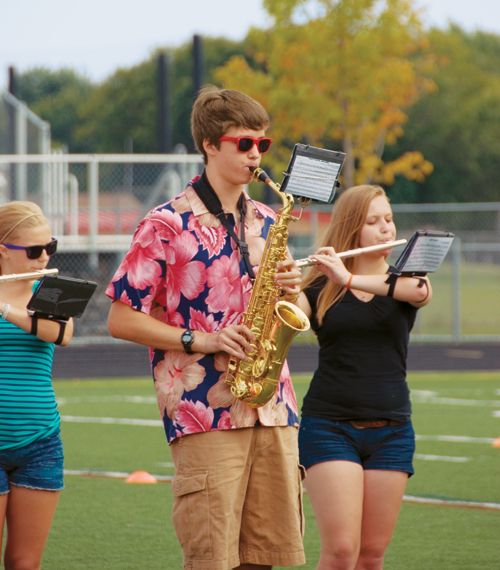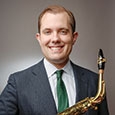
Woodwinds should be a vital component of any marching band. However, they are rarely used to their full potential on the field. Here are some tips to get the most out of the woodwinds during marching season.
Instrumentation
The first question for any band director should be which instruments to use in marching band. A full woodwind section in a concert band will sound brilliant on stage, but this same configuration doesn’t cut it on the field. For a full and well-balanced outdoor sound, the ideal marching woodwind section should be comprised of one or two piccolos, a rather large number of flutes, a very large number of clarinets, quite a few alto saxophones, and a relatively small number of tenor saxophones. Tenors add to the overall sound of the marching band quite well, but they often play parts similar to the trombones, making a large number unnecessary if the trombone section is of adequate size.
Piccolos
Some schools only march piccolos, and others use both flutes and piccolos but still march six or seven piccolos. There is no need for this many piccolos, because in the right register the instrument is easy to hear. Few flutists start high school with experience playing piccolo, and marching band is the worst possible ensemble in which to play piccolo for the first time. Students don’t realize how different the intonation tendencies can be from those of a flute, and this can lead to many tuning problems, made doubly likely if the piccolos are in poor shape.
The ideal solution is to take the two best flutists, have them march piccolo, and keep everyone else on flute. If there are a good number of flutes playing in the right register (not below B4), accompanied by two great piccolo players, you will hear this section just fine with far fewer intonation problems.
Bass Clarinets
Bass clarinets are of little use outside. If funding is available to build a marching bass clarinet section of at least six players, this is enough to make a difference on the field, but for average programs the expense in cash and personnel is rarely worth it. These are extraordinarily expensive, delicate instruments best used only in concert band.
Marching bass clarinetists are frequently used to double tenor saxophone or low brass parts, but another rarely considered use is to have them double the Bb clarinets down an octave. This adds heft to the clarinet parts and produces a good single-reed sound.
Baritone Saxophones
Like bass clarinets, these instruments serve a vital role in concert band, but the potential to destroy these large, delicate machines is far too great for their rather negligible role in a marching band. At best, marching with baritone saxophones is inadvisable because of their weight, and in larger ensembles with sufficient numbers of sousaphones or convertible tubas, they are entirely unnecessary. I marched bari sax my first two years of high school and still have neck and back problems from it. If a director chooses to march baris, it is an absolute necessity to invest in high-quality, well-fitting harnesses for the players.
Double Reeds
Nearly all bands forgo the use of the double-reeds while marching. These instruments are incredibly expensive and fragile and are generally inaudible in a marching band. If an oboe or bassoon is being used for a solo in the show, it should be microphoned, and great care should be taken to ensure that the instrument is not damaged in the process. Be aware of where the color guard is compared to the location of a double reed instrument on the sideline, so it is not knocked off its stand by an errant flag or rifle toss.
Getting the Best Sound
The obstacle woodwinds face in projecting on the field is that unlike brass instruments, which are intense, directional sound generators, woodwinds have numerous toneholes that allow the sound to exit the instrument in a diffuse way, yielding a tone that has much more difficulty traveling to an audience in the open air. This means that it takes quite a few woodwinds to equal the volume of even one brass instrument, and if the trumpet or trombone sections of a program are considerably larger than the flute or clarinet sections, the marching band will sound out of balance and very brass heavy, all other things being equal.
Woodwind players, in an effort to be heard, can very often get into bad habits of overblowing, biting (for single-reeds), and playing with very bright, edgy sounds. Very often these tendencies find their way into concert band. Therefore, it is incredibly important to properly balance and write for the band to begin with, so that the flutists, clarinetists, and saxophonists will never feel compelled to resort to drastic measures.
The easiest and quickest way to create a balanced sound on the field is with music selection. If flutes and clarinets only ever play in unison with trumpets, they will rarely be heard. It is better to select or arrange music that has the woodwinds featured as an independent voice from the brass. Additionally, part division should be simple. There should be at most two clarinet parts and one doubled flute/piccolo part, one alto sax part, and one tenor sax part. Keep the woodwinds playing as a section; the field is no place for four separate clarinet parts.
Playing in tune is never unimportant, but it is especially important for marching woodwinds. If everyone is in tune, the sound is much fuller than if everyone is out of tune. An in-tune section of 20-30 clarinets will sound a lot louder than a section of 20-30 out-of-tune clarinets.
When it comes to fullness of sound, avoid asking woodwind players to push. Although this word seems to work well for getting brass players to use more air, woodwind players hear it and start blowing from the front of the embouchure. They close off the throat and become tense, leading to a small stream of air, a bright sound, and intonation that is all over the map. For indoor and outdoor playing, woodwind players should focus on getting a good, full breath and using all that air. The lower in the abdomen woodwinds feel like they play from, the bigger sound they will get. The greatest jazz saxophonists can fill a room with sound this way. Power playing with good sound and intonation comes from a full and relaxed breath. This is true both indoors and out.
Show Design
I frequently have heard arrangements in which there is a call and response between brass and woodwinds. Although this works well if the right steps are taken, when the brass are grouped together on one side of the field and the woodwinds are grouped together on the other with all instruments to the front sideline, this will very rarely sound well-balanced, even with good instrumentation. A much better idea would be to stage the woodwinds much closer to the sideline and the brass much farther away, or to have the brass play backfield.
If the brass are in front, avoid staging woodwinds too far backfield; they should still be close to the front. If the brass are in front and the woodwinds are far in the back, the woodwinds won’t be heard. In addition, avoid spacing woodwinds far from each other; like instruments should hear each other. If everybody is spread out, they will never be able to lock in on intonation, and the sound will suffer. Keep the whole clarinet section close together. Break the section in half or thirds if there are enough players, but keep groups close to each other.
A final pitfall is charting a big transition during a woodwind feature. If woodwinds have to make a far-away spot while playing an important line, it will not come out as well as if they were standing still or only moving a little.
Horn Angles
The temptation to over-exaggerate posture should be avoided. Students should never tilt their heads backward. This can lead to health problems and will have an adverse effect on the sound of all of the woodwinds. This position hinders the airstream, and both clarinetists and saxophonists will be exerting upward pressure on the reed, leading to a thin, less-than-desirable sound. Another area of concern is instrument carriage and angle. In an effort to look disciplined, many students allow substantial tension to creep into their arms and hands, resulting in vastly slowed-down finger action. In stressing a uniform appearance, attention should be given to ensuring that students are as relaxed in their back, arms, hands, and neck as possible.
Flutists suffer the most from overextended posture. Upright posture and a properly-supported flute will be much more advantageous to the sound of the ensemble than will an over-tensed flutist who is gripping the flute in a way that makes technical passages impossible.
Clarinetists should be watched carefully, as they have a tendency to swing their instruments out much too far, resulting in poor tone quality. The clarinet should still be held at the same angle as it would be in concert band.
The normally accepted method of holding the saxophone is impossible while marching. In concert playing, while standing, the saxophone must be supported by the neckstrap, but it should also always make contact somewhere on the saxophonist’s leg rather than being held out from the body by the right hand. When the saxophone is held out, it can lead to great tension, loss of mobility in the right fingers, and eventual health problems, such as tendinitis. However, to keep from injuring themselves, saxophonists must hold the horn out from their bodies a bit while marching. It should be made clear to the young performers that this should only happen while they are in motion, and that the saxophone should be in contact with their body the rest of the time. The neckstrap should always be pulled up far enough that the head can remain erect and so that the saxophonist does not have to lift the horn.
Flashy horn angles should be taught with an eye toward how the instrument should be played. Clarinets and saxophones should remain as close to a normal playing position as possible. If the band is standing and playing, woodwind players can lean back a little at the waist, but the head should not be tilted back, and the arms should not be flared out. The tone will be terrible. Holding the instrument four to five inches from the body and leaning back a bit is much healthier and will sound better.
A fine marching band is a wonderful component of an instrumental music program, providing public relations and many other benefits for the band program. Woodwinds have an extremely important role within this ensemble. Giving them every opportunity to make their voices heard can help make it an excellent marching season.






